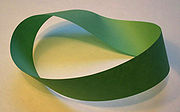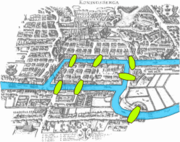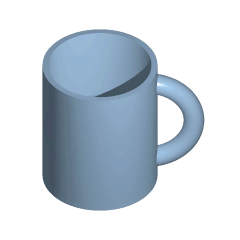
Topology
About this schools Wikipedia selection
SOS Children made this Wikipedia selection alongside other schools resources. A good way to help other children is by sponsoring a child
Topology (Greek topos, "place," and logos, "study") is a branch of mathematics that is an extension of geometry. Topology begins with a consideration of the nature of space, investigating both its fine structure and its global structure. Topology builds on set theory, considering both sets of points and families of sets.
The word topology is used both for the area of study and for a family of sets with certain properties described below that are used to define a topological space. Of particular importance in the study of topology are functions or maps that are homeomorphisms. Informally, these functions can be thought of as those that stretch space without tearing it apart or sticking distinct parts together.
When the discipline was first properly founded, toward the end of the 19th century, it was called geometria situs (Latin geometry of place) and analysis situs (Latin analysis of place). From around 1925 to 1975 it was an important growth area within mathematics.
Topology is a large branch of mathematics that includes many subfields. The most basic division within topology is point-set topology, which investigates such concepts as compactness, connectedness, and countability; algebraic topology, which investigates such concepts as homotopy and homology; and geometric topology, which studies manifolds and their embeddings, including knot theory.
See also: topology glossary for definitions of some of the terms used in topology and topological space for a more technical treatment of the subject.
History
The branch of mathematics now called topology began with the investigation of certain questions in geometry. Leonhard Euler's 1736 paper on Seven Bridges of Königsberg is regarded as one of the first topological results.
The term "topologie" was introduced in German in 1847 by Johann Benedict Listing in Vorstudien zur Topologie, Vandenhoeck und Ruprecht, Göttingen, pp. 67, 1848. However, Listing had already used the word for ten years in correspondence. "Topology", its English form, was introduced in 1883 in the journal Nature to distinguish "qualitative geometry from the ordinary geometry in which quantitative relations chiefly are treated". The term topologist in the sense of a specialist in topology was used in 1905 in the magazine Spectator.
Modern topology depends strongly on the ideas of set theory, developed by Georg Cantor in the later part of the 19th century. Cantor, in addition to setting down the basic ideas of set theory, considered point sets in Euclidean space, as part of his study of Fourier series.
Henri Poincaré published Analysis Situs in 1895, introducing the concepts of homotopy and homology, which are now considered part of algebraic topology.
Maurice Fréchet, unifying the work on function spaces of Cantor, Volterra, Arzelà, Hadamard, Ascoli and others, introduced the metric space in 1906. A metric space is now considered a special case of a general topological space. In 1914, Felix Hausdorff coined the term "topological space" and gave the definition for what is now called a Hausdorff space. In current usage, a topological space is a slight generalization of Hausdorff spaces, given in 1922 by Kazimierz Kuratowski.
For further developments, see point-set topology and algebraic topology.
Elementary introduction
Topological spaces show up naturally in almost every branch of mathematics. This has made topology one of the great unifying ideas of mathematics. General topology, or point-set topology, defines and studies properties of spaces and maps such as connectedness, compactness and continuity. Algebraic topology uses structures from abstract algebra, especially the group to study topological spaces and the maps between them.
The motivating insight behind topology is that some geometric problems depend not on the exact shape of the objects involved, but rather on the way they are put together. For example, the square and the circle have many properties in common: they are both one dimensional objects (from a topological point of view) and both separate the plane into two parts, the part inside and the part outside.
One of the first papers in topology was the demonstration, by Leonhard Euler, that it was impossible to find a route through the town of Königsberg (now Kaliningrad) that would cross each of its seven bridges exactly once. This result did not depend on the lengths of the bridges, nor on their distance from one another, but only on connectivity properties: which bridges are connected to which islands or riverbanks. This problem, the Seven Bridges of Königsberg, is now a famous problem in introductory mathematics, and led to the branch of mathematics known as graph theory.
Similarly, the hairy ball theorem of algebraic topology says that "one cannot comb the hair on a ball smooth." This fact is immediately convincing to most people, even though they might not recognize the more formal statement of the theorem, that there is no nonvanishing continuous tangent vector field on the sphere. As with the Bridges of Königsberg, the result does not depend on the exact shape of the sphere; it applies to pear shapes and in fact any kind of blob (subject to certain conditions on the smoothness of the surface), as long as it has no holes.
In order to deal with these problems that do not rely on the exact shape of the objects, one must be clear about just what properties these problems do rely on. From this need arises the notion of topological equivalence. The impossibility of crossing each bridge just once applies to any arrangement of bridges topologically equivalent to those in Königsberg, and the hairy ball theorem applies to any space topologically equivalent to a sphere.
Intuitively, two spaces are topologically equivalent if one can be deformed into the other without cutting or gluing. A traditional joke is that a topologist can't tell the coffee mug out of which she is drinking from the doughnut she is eating, since a sufficiently pliable doughnut could be reshaped to the form of a coffee cup by creating a dimple and progressively enlarging it, while shrinking the hole into a handle.
A simple introductory exercise is to classify the lowercase letters of the English alphabet according to topological equivalence. (The lines of the letters are assumed to have non-zero width.) In most fonts in modern use, there is a class {a, b, d, e, o, p, q} of letters with one hole, a class {c, f, h, k, l, m, n, r, s, t, u, v, w, x, y, z} of letters without a hole, and a class {i, j} of letters consisting of two pieces. g may either belong in the class with one hole, or (in some fonts) it may be the sole element of a class of letters with two holes, depending on whether or not the tail is closed. For a more complicated exercise, it may be assumed that the lines have zero width; one can get several different classifications depending on which font is used. Letter topology is of practical relevance in stencil typography: The font Braggadocio, for instance, can be cut out of a plane without falling apart.
Mathematical definition
Let X be any set and let T be a family of subsets of X. Then T is a topology on X if
- Both the empty set and X are elements of T.
- Any union of arbitrarily many elements of T is an element of T.
- Any intersection of finitely many elements of T is an element of T.
If T is a topology on X, then X together with T is called a topological space.
All sets in T are called open; note that in general not all subsets of X need be in T. A subset of X is said to be closed if its complement is in T (i.e., it is open). A subset of X may be open, closed, both, or neither.
A function or map from one topological space to another is called continuous if the inverse image of any open set is open. If the function maps the real numbers to the real numbers (both space with the Standard Topology), then this definition of continuous is equivalent to the definition of continuous in calculus. If a continuous function is one-to-one and onto and if the inverse of the function is also continuous, then the function is called a homeomorphism and the domain of the function is said to be homeomorphic to the range. Another way of saying this is that the function has a natural extension to the topology. If two spaces are homeomorphic, they have identical topological properties, and are considered to be topologically the same. The cube and the sphere are homeomorphic, as are the coffee cup and the doughnut. But the circle is not homeomorphic to the doughnut.
Some theorems in general topology
- Every closed interval in R of finite length is compact. More is true: In Rn, a set is compact if and only if it is closed and bounded. (See Heine-Borel theorem).
- Every continuous image of a compact space is compact.
- Tychonoff's theorem: The (arbitrary) product of compact spaces is compact.
- A compact subspace of a Hausdorff space is closed.
- Every sequence of points in a compact metric space has a convergent subsequence.
- Every interval in R is connected.
- The continuous image of a connected space is connected.
- A metric space is Hausdorff, also normal and paracompact.
- The metrization theorems provide necessary and sufficient conditions for a topology to come from a metric.
- The Tietze extension theorem: In a normal space, every continuous real-valued function defined on a closed subspace can be extended to a continuous map defined on the whole space.
- The Baire category theorem: If X is a complete metric space or a locally compact Hausdorff space, then the interior of every union of countably many nowhere dense sets is empty.
- On a paracompact Hausdorff space every open cover admits a partition of unity subordinate to the cover.
- Every path-connected, locally path-connected and semi-locally simply connected space has a universal cover.
General topology also has some surprising connections to other areas of mathematics. For example:
- in number theory, Furstenberg's proof of the infinitude of primes.
Some useful notions from algebraic topology
See also list of algebraic topology topics.
- Homology and cohomology: Betti numbers, Euler characteristic.
- Intuitively-attractive applications: Brouwer fixed-point theorem, Hairy ball theorem, Borsuk-Ulam theorem, Ham sandwich theorem.
- Homotopy groups (including the fundamental group).
- Chern classes, Stiefel-Whitney classes, Pontryagin classes.
Generalizations
Occasionally, one needs to use the tools of topology but a "set of points" is not available. In pointless topology one considers instead the lattice of open sets as the basic notion of the theory, while Grothendieck topologies are certain structures defined on arbitrary categories which allow the definition of sheaves on those categories, and with that the definition of quite general cohomology theories.




